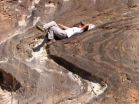(Press-News.org) Washington, DC (April 3, 2014) — Kidney disease patients with poor quality of life are at increased risk of experiencing progression of their disease and of developing heart problems, according to a study appearing in an upcoming issue of the Journal of the American Society of Nephrology (JASN). The findings suggest that quality of life measurements may have important prognostic value in these individuals.
Approximately 60 million people globally have chronic kidney disease (CKD). Quality of life has been well-studied in patients with end-stage kidney disease, but not in patients with CKD who do not yet require dialysis. To gain a better understanding of quality of life among such patients, Anna Porter, MD (University of Illinois at Chicago) and her colleagues studied1091 African Americans with hypertensive CKD enrolled in the African American Study of Kidney Disease and Hypertension Trial and Cohort Studies. The researchers assessed health-related quality of life, including mental and physical health, through surveys.
During approximately 10 years of follow-up, lower physical and mental health scores were linked with increased risks of experiencing cardiovascular events or dying from heart-related causes as well as with experiencing progression of CKD or dying from kidney-related causes.
"Quality of life is extremely important to patients and is impacted by kidney disease," said Dr. Porter. "In order to better serve our patients, physicians need to gain a better understanding of the negative impact that kidney disease has on quality of life, and to recognize the association between quality of life and other outcomes."
INFORMATION:
Highlight
In African American patients with chronic kidney disease, poor quality of life was linked with increased risks of disease progression and heart problems.
60 million people globally have chronic kidney disease.
Study co-authors include Michael Fischer, MD, Xuelei Wang, Deborah Brooks, Marino Bruce, PhD, Jeanne Charleston, William Cleveland, MD, Donna Dowie, MD, Marquetta Faulkner, MD, Jennifer Gassman, PhD, Leena Hiremath, PhD, Cindy Kendrick, John W. Kusek, PhD, Keith C. Norris, MD, Denyse Thornley-Brown, MD, Tom Greene, PhD, and James Lash, MD.
Disclosures: Keith Norris has consulted with Amgen, Pfizer, Merck, King Pharmaceuticals and Abbott; received grants from NIH and King Pharmaceuticals; and received honoraria from Amgen. His co-authors reported no financial disclosures.
The article, entitled "Quality of Life and Outcomes in African Americans with CKD," will appear online at http://jasn.asnjournals.org/ on April 3, 2014.
The content of this article does not reflect the views or opinions of The American Society of Nephrology (ASN). Responsibility for the information and views expressed therein lies entirely with the author(s). ASN does not offer medical advice. All content in ASN publications is for informational purposes only, and is not intended to cover all possible uses, directions, precautions, drug interactions, or adverse effects. This content should not be used during a medical emergency or for the diagnosis or treatment of any medical condition. Please consult your doctor or other qualified health care provider if you have any questions about a medical condition, or before taking any drug, changing your diet or commencing or discontinuing any course of treatment. Do not ignore or delay obtaining professional medical advice because of information accessed through ASN. Call 911 or your doctor for all medical emergencies.
Founded in 1966, and with more than 14,000 members, the American Society of Nephrology (ASN) leads the fight against kidney disease by educating health professionals, sharing new knowledge, advancing research, and advocating the highest quality care for patients.
Poor quality of life may contribute to kidney disease patients' health problems
Future studies should assess whether improving quality of life can protect patients' health
2014-04-04
ELSE PRESS RELEASES FROM THIS DATE:
Walking may help protect kidney patients against heart disease and infections
2014-04-04
Washington, DC (April 3, 2014) — Just a modest amount of exercise may help reduce kidney disease patients' risks of developing heart disease and infections, according to a study appearing in an upcoming issue of the Journal of the American Society of Nephrology (JASN).
Heart disease and infection are major complications and the leading causes of death in patients with chronic kidney disease. It is now well established that immune system dysfunction is involved in both of these pathological processes. Specifically, impaired immune function predisposes to infection, while ...
Insomnia may significantly increase stroke risk
2014-04-03
The risk of stroke may be much higher in people with insomnia compared to those who don't have trouble sleeping, according to new research in the American Heart Association journal Stroke.
The risk also seems to be far greater when insomnia occurs as a young adult compared to those who are older, said researchers who reviewed the randomly-selected health records of more than 21,000 people with insomnia and 64,000 non-insomniacs in Taiwan.
They found:
Insomnia raised the likelihood of subsequent hospitalization for stroke by 54 percent over four years.
The incidence ...
Higher total folate intake may be associated with lower risk of exfoliation glaucoma
2014-04-03
BOSTON (April 4, 2014) — Exfoliation glaucoma (EG), caused by exfoliation syndrome, a condition in which white clumps of fibrillar material form in the eye, is the most common cause of secondary open-angle glaucoma and a leading cause of blindness and visual impairment. Effective strategies for preventing this disease are lacking.
Elevated homocysteine, which may enhance exfoliation material formation, is one possible risk factor that has received significant research attention. Research studies demonstrate that high intake of vitamin B6, vitamin B12 and folate ...
Off the shelf, on the skin: Stick-on electronic patches for health monitoring
2014-04-03
CHAMPAIGN, Ill. — Wearing a fitness tracker on your wrist or clipped to your belt is so 2013.
Engineers at the University of Illinois at Urbana-Champaign and Northwestern University have demonstrated thin, soft stick-on patches that stretch and move with the skin and incorporate commercial, off-the-shelf chip-based electronics for sophisticated wireless health monitoring.
The patches stick to the skin like a temporary tattoo and incorporate a unique microfluidic construction with wires folded like origami to allow the patch to bend and flex without being constrained ...
Geology spans the minute and gigantic, from skeletonized leaves in China to water on mars
2014-04-03
Boulder, Colo., USA – New Geology studies include a mid-Cretaceous greenhouse world; the Vredefort meteoric impact event and the Vredefort dome, South Africa; shallow creeping faults in Italy; a global sink for immense amounts of water on Mars; the Funeral Mountains, USA; insect-mediated skeletonization of fern leaves in China; first-ever tectonic geomorphology study in Bhutan; the Ethiopian Large Igneous Province; the Central Andean Plateau; the Scandinavian Ice Sheet; the India-Asia collision zone; the Snake River Plain; and northeast Brazil.
Highlights are provided ...
Calcium waves help the roots tell the shoots
2014-04-03
MADISON – For Simon Gilroy, sometimes seeing is believing. In this case, it was seeing the wave of calcium sweep root-to-shoot in the plants the University of Wisconsin-Madison professor of botany is studying that made him a believer.
Gilroy and colleagues, in a March 24, 2014 paper in the Proceedings of the National Academy of Sciences, showed what long had been suspected but long had eluded scientists: that calcium is involved in rapid plant cell communication.
It's a finding that has implications for those interested in how plants adapt to and thrive in changing ...
Smoking may dull obese women's ability to taste fat and sugar
2014-04-03
Cigarette smoking among obese women appears to interfere with their ability to taste fats and sweets, a new study shows. Despite craving high-fat, sugary foods, these women were less likely than others to perceive these tastes, which may drive them to consume more calories.
M. Yanina Pepino, PhD, assistant professor of medicine at Washington University School of Medicine in St. Louis, and Julie Mennella, PhD, a biopsychologist at the Monell Center in Philadelphia, where the research was conducted, studied four groups of women ages 21 to 41: obese smokers, obese nonsmokers, ...
Dose-escalated hypofractionated IMRT, conventional IMRT for prostate cancer have like side effects
2014-04-03
Fairfax, Va., April 3, 2014—Dose-escalated intensity modulated radiation therapy (IMRT) with use of a moderate hypofractionation regimen (72 Gy in 2.4 Gy fractions) can safely treat patients with localized prostate cancer with limited grade 2 or 3 late toxicity, according to a study published in the April 1, 2014 edition of the International Journal of Radiation Oncology · Biology · Physics (Red Journal), the official scientific journal of the American Society for Radiation Oncology (ASTRO).
Previous randomized clinical trials have shown that dose-escalated ...
Fences cause 'ecological meltdown'
2014-04-03
NEW YORK (Embargoed – Not for release until 14:00 EST 3 April 2014) Wildlife fences are constructed for a variety of reasons including to prevent the spread of diseases, protect wildlife from poachers, and to help manage small populations of threatened species. Human–wildlife conflict is another common reason for building fences: Wildlife can damage valuable livestock, crops, or infrastructure, some species carry diseases of agricultural concern, and a few threaten human lives. At the same time, people kill wild animals for food, trade, or to defend lives or property, and ...
Quantum photon properties revealed in another particle -- the plasmon
2014-04-03
For years, researchers have been interested in developing quantum computers—the theoretical next generation of technology that will outperform conventional computers. Instead of holding data in bits, the digital units used by computers today, quantum computers store information in units called "qubits." One approach for computing with qubits relies on the creation of two single photons that interfere with one another in a device called a waveguide. Results from a recent applied science study at Caltech support the idea that waveguides coupled with another quantum particle—the ...
LAST 30 PRESS RELEASES:
The impact of family dynamics on eating behaviour – how going home for Christmas can change how you eat
Tracing the quick synthesis of an industrially important catalyst
New software sheds light on cancer’s hidden genetic networks
UT Health San Antonio awarded $3 million in CPRIT grants to bolster cancer research and prevention efforts in South Texas
Third symposium spotlights global challenge of new contaminants in China’s fight against pollution
From straw to soil harmony: International team reveals how biochar supercharges carbon-smart farming
Myeloma: How AI is redrawing the map of cancer care
Manhattan E. Charurat, Ph.D., MHS invested as the Homer and Martha Gudelsky Distinguished Professor in Medicine at the University of Maryland School of Medicine
Insilico Medicine’s Pharma.AI Q4 Winter Launch Recap: Revolutionizing drug discovery with cutting-edge AI innovations, accelerating the path to pharmaceutical superintelligence
Nanoplastics have diet-dependent impacts on digestive system health
Brain neuron death occurs throughout life and increases with age, a natural human protein drug may halt neuron death in Alzheimer’s disease
SPIE and CLP announce the recipients of the 2025 Advanced Photonics Young Innovator Award
Lessons from the Caldor Fire’s Christmas Valley ‘Miracle’
Ant societies rose by trading individual protection for collective power
Research reveals how ancient viral DNA shapes early embryonic development
A molecular gatekeeper that controls protein synthesis
New ‘cloaking device’ concept to shield sensitive tech from magnetic fields
Researchers show impact of mountain building and climate change on alpine biodiversity
Study models the transition from Neanderthals to modern humans in Europe
University of Phoenix College of Doctoral Studies releases white paper on AI-driven skilling to reduce burnout and restore worker autonomy
AIs fail at the game of visual “telephone”
The levers for a sustainable food system
Potential changes in US homelessness by ending federal support for housing first programs
Vulnerability of large language models to prompt injection when providing medical advice
Researchers develop new system for high-energy-density, long-life, multi-electron transfer bromine-based flow batteries
Ending federal support for housing first programs could increase U.S. homelessness by 5% in one year, new JAMA study finds
New research uncovers molecular ‘safety switch’ shielding cancers from immune attack
Bacteria resisting viral infection can still sink carbon to ocean floor
Younger biological age may increase depression risk in older women during COVID-19
Bharat Innovates 2026 National Basecamp Showcases India’s Most Promising Deep-Tech Ventures
[Press-News.org] Poor quality of life may contribute to kidney disease patients' health problemsFuture studies should assess whether improving quality of life can protect patients' health



